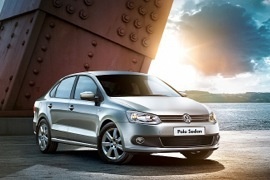
VOLKSWAGEN Polo Sedan
Generations Timeline, Specs and Pictures

The Polo sedan was a good choice for the emergent markets, for the families that didn’t want to share the cabin with their luggage compartment.
Small, nimble, and light, the Polo sedan was a great choice for countries where the three-box version was considered more upmarket than the hatchbacks. In the ASEAN market, Russia, and specific market, Volkswagen offered a three-box version for its well-known Polo from the fifth generation.
From the outside, the Polo Sedan featured the same front fascia as the rest of the range, with angular-looking headlights and a two-slats grille design with chromed accents. Depending on the trim level, the aerodynamically profiled bumper featured a pair of round fog lights installed on the outer section. In the middle, the carmaker installed an additional grille to cool the engine. The three-box version featured a third triangular window behind the rear C-pillar and a sloped D-pillar from its sides. Its taillights were mounted only on the rear quarter panels.
Inside, the Polo Sedan offered adequate space for four passengers but with limited legroom for the rear seat occupants. The carmaker installed a pair of seats designed for comfort rather than for spirited driving at the front. While the dashboard design was similar to the sedan version, but with a slightly different instrument panel design, especially for the tachometer and speedometer.
Depending on the market, the Polo Sedan was available either with two gasoline engines or a 1.5-liter turbodiesel.

With the new East-European market opened after the fall of the communist regimes, Volkswagen had to adapt and produce something for its new customers, and the Polo Sedan was a perfect solution.
While the West-European customers were not interested in small-class sedan vehicles, the East-Europeans were very attracted to those types of sedans. In their minds, the sedan was the symbol of an upmarket vehicle, while the station wagon or the hatchback had a utilitarian or low-budget look. Volkswagen remembered that in the early ’80s, it offered the Polo in a three-box shape, and it enjoyed mild success. In 1996 it returned with the same idea but fixed the biggest mistake they did in the first place and added another set of doors for the rear passengers.
It was harder for a carmaker to create a new platform than to design a new bodywork for a vehicle it already produced. For Volkswagen, it was even easier to transform the five-door Polo into a four-door sedan version. It just had to add a separate trunk and develop a few body panels for it. Of course. The result was quite a balanced-looking vehicle. Up to the rear doors, it was the same third-generation Polo, but with a different C-pillar, another small side window and a different ending. It was a good idea to make the trunk higher than the windows line, thus creating a sportier image.
Inside, the carmaker fitted the car with the same options as the sedan. Volkswagen decided to keep the rear bench with a split-folding system to help its customers load longer items. Soon, the car became a hit among the customers who preferred the three-box sedans over the five-door hatchbacks.























































